| Kawasaki
2003 new models
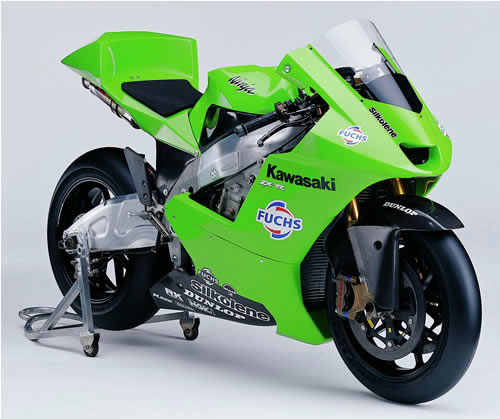
The new Kawasaki 990 MotoGP Bike
Kawasaki’s
MotoGP Bike follows conventional design
Of all the manufacturers in MotoGP for 2003, the new Kawasaki
990 which was unveiled in testing during the summer of 2002, is
probably the most conventional design employing an inline 4-cylinder
DOHC engine in a an aluminum perimeter frame very similar to their
current production ZXR sportbikes. For the smallest of the Japanese
big four manufacturers this design holds the least risk and makes
the most sense, particularly since it can serve as the race track
tested prototype for Kawasaki's long awaited next generation ZXR
Superbike which will meet the new 1000cc displacement limit for
Superbikes beginning with the 2003 season as well.
Former Kawasaki
WSB superbike rider Akira Yanagawa sat out the 2002 race season
to develop this bike, and he will be the factory's principal rider
for the 2003 season. Akira did race this bike in the last 2 MotoGP
races of the 2002 season, but it still proved to be down on power
and he never ran in the top 10. The lack of a slipper clutch on
the high compression engine also caused Akirato crash the first
time he raced it as the rear wheel locked up backing off the throttle
into a corner. The bike will have a slipper clutch and more power
by the time the 2003 season gets under way. American Eric Bostrom
will also race at selected MotoGP races which don't conflict with
his AMA schedule in 2003, and then in 2004 Eric will either move
to MotoGP on this bike or race Superbike on the new 2004 model
ZXR1000.
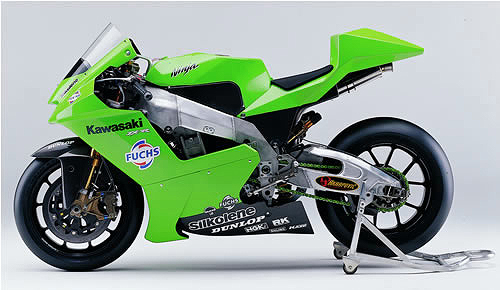 |
The
very convential design of the new Kawasaki MotoGP bike leaves
nothing to risk for the smallest of the four Japanese manufacturers,
and serves as a prototype for their upcoming new 2004 ZXR1000
Superbike. |
Kawasaki’s
all new In-line, 4-cylinder MotoGP engine.
During the early conceptual stages of development, a variety
of engine layouts were considered. However, due to the many
technical advantages of this configuration, this choice
of engine architecture was deemed most appropriate.
The main reasons for choosing this layout are as follows:
1.
Compared with a V-engine, the evenly spaced firing intervals
of the In-line Four greatly simplify tuning of the intake
and exhaust systems. Another related benefit is perfect
primary balance, obviating the need for a balancer. In other
words, it is an inherently well-balanced engine. |
 |
2. To achieve
the desirable power characteristics with a 4-stroke engine, a rather
long exhaust system is needed. However, the unequal front/rear spacing
of, for example, a V-engine’s exhaust ports, requires complex
exhaust plumbing to achieve the required lengths. Obviously, the
In-line Four design eliminates these problems and gives the engineers
a great deal of latitude in tuning the exhaust system for the desired
power characteristics.
3. Compared to a V-engine, the In-line Four engine’s compact
cylinder head makes it much easier to mount in a frame.
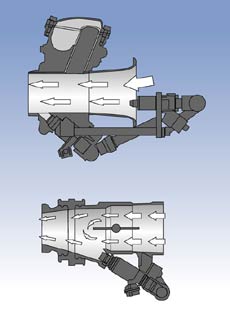
Fuel
injection will make it easier to control fuel consumption
when the fuel capacity regulations come into effect in 2004.
Right: Injector sprays down into the bell mouth like Ducati's
Superbikes.
|
Kawasaki's
MotoGP Fuel Injection
This sophisticated fuel injection system combines the advantages
of a carburetor with the advantages of fuel injection.The
Keihin FCR-i system used by Kawasaki resembles a FCR carburetor.
Unlike conventional fuel injection systems, which usually
locate an obstructing butterfly valve in the intake tract
(see lower left diagram), this system uses a slide like
that used on a FCR carburetor. As a result, when the throttle
is fully open there is no obstruction in the intake tract,
and flow through the intake tract is greatly improved (see
upper left diagram).
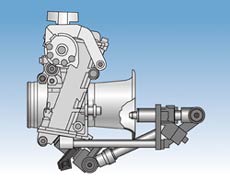
|
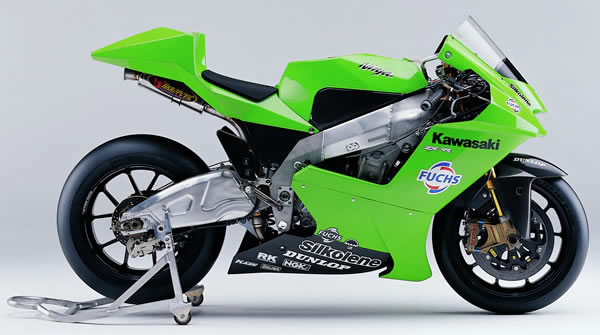
Return
to • Kawasaki
• Pit
Lane News
|
